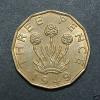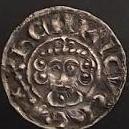Well I’m still learning myself, maybe I got lucky with the two I’ve put up here but it can be a bit hit and miss I’m afraid. The method I’m using at the moment is a heat source, I’m using the wife’s creme brûlée torch, a pair of tweezers and a bowl of water. Firstly though try and get the bent coin clean of mud using distilled water and cotton buds, if you can run a soft wet cloth between the joint if folded right over. Dry it. Darken the room, this makes it easier to see when the coin reaches cherry red when you heat it. Next I set the flame on the torch, I’m still playing around with that setting at the moment. I’ve read if you have it too fierce it’s not good and that you need a slight green flame to heat the coin. So then using the tweezers pick the coin up and play the flame over the coin from about 3 inches away. Keep the flame moving and don’t heat at one area. When you see the whole coin turning dull red, drop it into the cold water straight away. Now comes the part where it can go horribly wrong, so don’t blame me. I suggest you have a go on some grotty looking hammereds to start with. Then using an assortment of different diameter round wooden sticks like chop sticks or kebab skewers, starting with the smallest first, I use a small wooden tapered wedge, slowly push the stick between the two sides of the coin. The coin should start to part quite easily, if it doesn’t you haven’t annealed it properly and so will have to go back and reheat it again. Basically you keep doing this , slowly opening the coin a little at a time using slightly bigger diameter sticks, each time heating and quenching till the coin is nearly flat . The last bit I put the coin between two bits of soft wood or lead and squeeze together in a vice. And with a bit of luck the coin stays in one piece.
Here endeth the lesson
Good luck
 Coinpublications.com
Coinpublications.com




